
The first HMS Montrose was one of eight Admiralty-type destroyer leaders, sometimes known as the Scott class. They were named after figures from Scottish history; Montrose was named for the Graham Dukes of Montrose. She was built during the First World War, but was completed too late for service then. However, she had a long career in the inter-war years and saw extensive service during the Second World War.

HMS Jaguar was a J-class destroyer of the Royal Navy. Commissioned in September 1939, she was present at the Dunkirk evacuation the following year, during which Jaguar was damaged by dive bombers. She later served in the Mediterranean and was involved in several actions there. She was torpedoed off the coast of Egypt on 26 March 1942 and sunk.
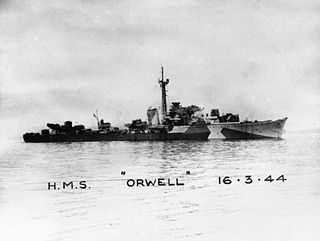
HMS Orwell was an O-class destroyer of the Royal Navy that entered service in 1942 and was broken up in 1965.
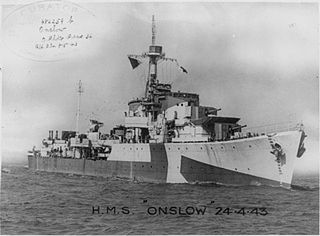
HMS Onslow was an O-class destroyer of the Royal Navy. The O-class were intermediate destroyers, designed before the outbreak of the Second World War to meet likely demands for large number of destroyers. They had a main gun armament of four 4.7 in guns, and had a design speed of 36 kn. Onslow was ordered on 2 October 1939 and was built by John Brown & Company at their Clydebank, Glasgow shipyard, launching on 31 March 1941 and completing on 8 October 1941.
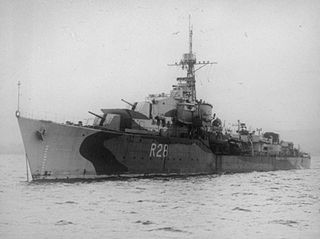
HMS Verulam was a V-class destroyer of the British Royal Navy that saw service during the Second World War.

HMS Paladin was a P-class destroyer of the Royal Navy that served in the Second World War. She was built by John Brown and Co. Ltd., Clydebank. She saw action in the Mediterranean and Far East. After the war she was converted into a type 16 frigate and was eventually scrapped in 1962.

HMS Termagant was a T-class destroyer of the Royal Navy that saw service during the Second World War. She was built by William Denny and Brothers, of Dumbarton and launched on 22 March 1943. She was scrapped in 1965.
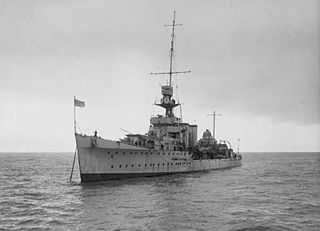
HMS Calcutta was a C-class light cruiser of the Royal Navy, named after the Indian city of Calcutta. She was part of the Carlisle group of the C class of cruisers. She was laid down by Vickers Limited at Barrow-in-Furness in 1917 and launched on 9 July 1918. Calcutta was commissioned too late to see action in the First World War and was converted to an anti-aircraft cruiser in 1939. Calcutta served during the Norwegian Campaign and the evacuation from Dunkirk in 1940. She was used to escort allied convoys across the Mediterranean and was sunk on 1 June 1941 by Luftwaffe aircraft off Alexandria, Egypt.

HMS Wrestler (D35) was a V and W-class destroyer built by the Royal Navy during the First World War and active from 1939 to 1944 during the Second World War. She was the first Royal Navy ship to bear that name, and the only one to do so to date.

HMS Westcott (D47) was a Royal Navy Admiralty W-class destroyer that served in the Second World War. In the Second World War Westcott served in an anti-submarine role and escorted numerous Atlantic and Malta convoys.

HMS Derwent was a Hunt-class Type III escort destroyer of the Royal Navy. She was built by Vickers-Armstrongs, in Barrow-in-Furness, and served during the Second World War. In March 1943, she was badly damaged while anchored in Tripoli harbour by aircraft and beached to prevent her from sinking. Temporarily repaired and towed to England, further repair work was halted in January 1945, and she was broken up for scrap in 1947.
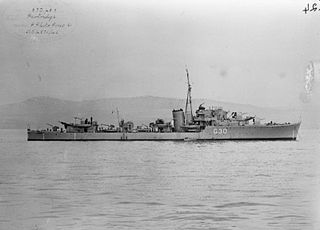
HMS Partridge was a P-class destroyer of the Royal Navy. The O-class were intermediate destroyers, designed before the outbreak of the Second World War to meet likely demands for large number of destroyers. They had a main gun armament of four 4.7 in guns, and had a design speed of 36 kn. Partridge was built by Fairfield Shipbuilding and Engineering Company at their Govan, Scotland shipyard, launching on 5 August 1941 and completing on 22 February 1942.

HMS Atherstone was a Hunt-class destroyer of the Royal Navy. She was launched in late 1939 as the first of her class but was found to be unstable, and had to undergo significant modifications before entering service in March 1940.

HMS Brocklesby was a Type I Hunt-class destroyer of the Royal Navy. She served during the Second World War, spending much of the time in the English Channel and Mediterranean, taking part in the Dieppe Raid in 1942, and the Allied landings in Sicily and at Salerno in 1943. After the war, she was used as a sonar trials ship until 1963, and was sold for scrap in 1968.

HMS Oakley was a Type II Hunt-class destroyer of the Royal Navy. She was originally to have been named Tickham, however she was renamed after her sister ship Oakley was transferred to Poland and was renamed ORP Kujawiak (L72). She entered service in May 1943, carrying out convoy escort, patrol and anti-shipping attacks for most of the rest of the Second World War. She was adopted by the Civil community of Leighton Buzzard in Bedfordshire as part of Warship Week in 1942. In 1957, she was sold to the West German Navy, serving as a training ship for the German Naval Gunnery school until scrapped in 1972.
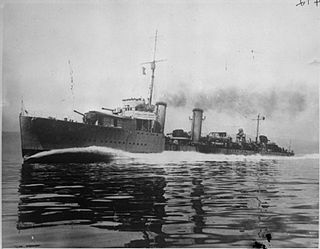
HMS Mackay was an Admiralty type, sometimes known as the Scott class, flotilla leader of the British Royal Navy. Mackay was built by Cammell Laird during the First World War, but was completed too late for service then, commissioning in 1919.
HMS Talybont was a Type III Hunt-class escort destroyer who served in the Royal Navy. She was launched in February 1943 and completed in May that year, serving for the rest of the Second World War. She took part in the Normandy Landings in June 1944, supporting the landings at Omaha Beach and the Pointe du Hoc. Post war she served in the Mediterranean before being reduced to reserve at the end of 1947. She was sold for scrap in 1961, with disposal completed by 1962.

HMS Airedale was a Hunt-class destroyer built for use by the British Royal Navy during the Second World War. She entered service in early 1942 as a convoy escort, being assigned to the Mediterranean Fleet in May. Airedale was sunk while escorting a convoy from Alexandria to Malta on 15 June 1942 by Sturzkampfgeschwader 3.
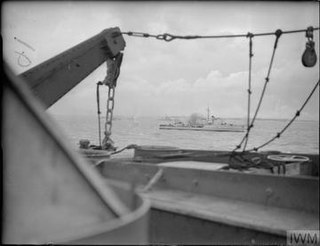
HMS Cottesmore was a Hunt-class destroyer of the British Royal Navy. The ship was built by the Scottish shipbuilder Yarrow at their Scotstoun, Glasgow shipyard in 1939–1940, being launched on 5 September 1940 and commissioning on 29 December that year.

HMS Easton was a Type III Hunt-class destroyer of the British Royal Navy. Easton was built by the shipbuilder J Samuel White in 1941–1942, being launched on 11 July 1942 and completed on 7 December 1942.




















